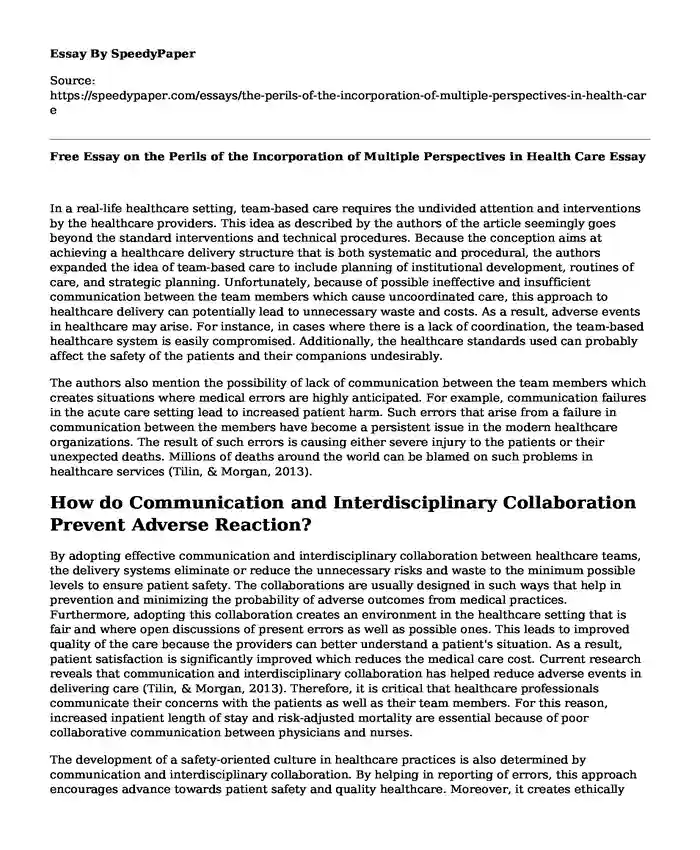
| Type of paper: | Essay |
| Categories: | Communication Healthcare |
| Pages: | 3 |
| Wordcount: | 596 words |
In a real-life healthcare setting, team-based care requires the undivided attention and interventions by the healthcare providers. This idea as described by the authors of the article seemingly goes beyond the standard interventions and technical procedures. Because the conception aims at achieving a healthcare delivery structure that is both systematic and procedural, the authors expanded the idea of team-based care to include planning of institutional development, routines of care, and strategic planning. Unfortunately, because of possible ineffective and insufficient communication between the team members which cause uncoordinated care, this approach to healthcare delivery can potentially lead to unnecessary waste and costs. As a result, adverse events in healthcare may arise. For instance, in cases where there is a lack of coordination, the team-based healthcare system is easily compromised. Additionally, the healthcare standards used can probably affect the safety of the patients and their companions undesirably.
The authors also mention the possibility of lack of communication between the team members which creates situations where medical errors are highly anticipated. For example, communication failures in the acute care setting lead to increased patient harm. Such errors that arise from a failure in communication between the members have become a persistent issue in the modern healthcare organizations. The result of such errors is causing either severe injury to the patients or their unexpected deaths. Millions of deaths around the world can be blamed on such problems in healthcare services (Tilin, & Morgan, 2013).
How do Communication and Interdisciplinary Collaboration Prevent Adverse Reaction?
By adopting effective communication and interdisciplinary collaboration between healthcare teams, the delivery systems eliminate or reduce the unnecessary risks and waste to the minimum possible levels to ensure patient safety. The collaborations are usually designed in such ways that help in prevention and minimizing the probability of adverse outcomes from medical practices. Furthermore, adopting this collaboration creates an environment in the healthcare setting that is fair and where open discussions of present errors as well as possible ones. This leads to improved quality of the care because the providers can better understand a patient's situation. As a result, patient satisfaction is significantly improved which reduces the medical care cost. Current research reveals that communication and interdisciplinary collaboration has helped reduce adverse events in delivering care (Tilin, & Morgan, 2013). Therefore, it is critical that healthcare professionals communicate their concerns with the patients as well as their team members. For this reason, increased inpatient length of stay and risk-adjusted mortality are essential because of poor collaborative communication between physicians and nurses.
The development of a safety-oriented culture in healthcare practices is also determined by communication and interdisciplinary collaboration. By helping in reporting of errors, this approach encourages advance towards patient safety and quality healthcare. Moreover, it creates ethically responsible healthcare professionals by allowing them to take responsibility for errors that occur by acknowledging their mistakes and communication errors. Communication and interdisciplinary collaboration ensure that errors are not only identified but also anticipating future issues and their possible solutions. Therefore, when the communication strategy uses the right channels in the healthcare delivery system, it will provide room for roundtable discussions of the outcomes which are arguably the best approach to developing a safety-oriented culture in healthcare practices.
References
Mitchell, P., Wynia, M., Golden, R., McNellis, B., Okun, S., Webb, C. E., ... & Von Kohorn, I. (2012). Core principles & values of effective team-based health care. Washington. DC: Discussion Paper, Institute of Medicine. DOI: 10.3109/13561820.2013.820906
Tilin, F. J., & Morgan, M. J. (2013). The Interprofessional Health Care Team: Leadership and Development (book). Jones & Bartlett Publishers. http://samples.jbpub.com/9781284112009/9781284112009_FMxx_PASS02.pdf
Cite this page
Free Essay on the Perils of the Incorporation of Multiple Perspectives in Health Care. (2022, Sep 19). Retrieved from https://speedypaper.net/essays/the-perils-of-the-incorporation-of-multiple-perspectives-in-health-care
Request Removal
If you are the original author of this essay and no longer wish to have it published on the SpeedyPaper website, please click below to request its removal:
- Essay Sample: Scrum and RUP Software Development Methods
- Free Essay Sample on How to Survive a Breakup
- Australian Automotive Industry Essay Sample
- Why Children Talk to Themselves - Free Essay Sample
- Reporting Welfare Cheaters - Case Study Paper Sample
- Free Essay Sample: Julius Caesar Leadership
- Essay Example on a News Story and Theories of Crime
Popular categories




